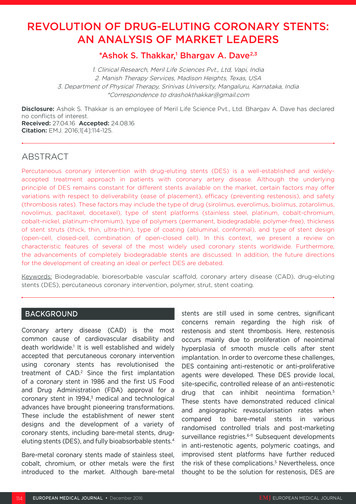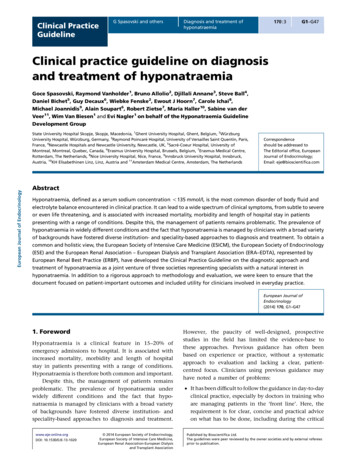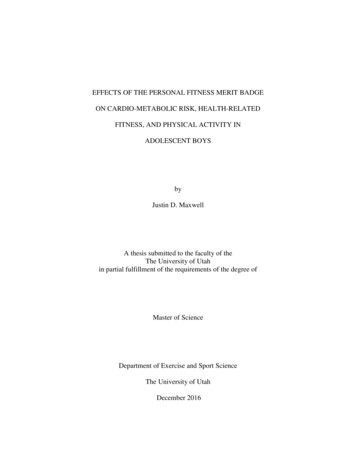
Transcription
EuropeanHealth & Fitness MarketReport 2020
This report covers the calendar year 2019, however we would liketo address briefly the dramatic developments in relation to theglobal Coronavirus (COVID-19) disease that is also heavily impactingEurope.Today, March 18, 2020 we have to finalize this report as it needs togo into final layout and printing in order to be ready for our releaseas planned on April 2nd.As you will read in this report, the year 2019 was again an excellentone for the sector and we know from discussions with leaders in theindustry that also the 1st quarter of 2020 had started very well.But in the last weeks we started to see initial effects of theCOVID-19 pandemic, which is by now impacting our sector in anunprecedented way.In many countries health & fitness facilities have been ordered toclose temporarily by governments or have closed voluntarily. Insome countries, even a complete “lock-down” of society has beenimposed and people have to stay at home.The good news is that our sector has evolved in the digital eraand developed many different ways for members beyond theclubs to stay active anywhere and anytime. Many operators areexperimenting with “digital fitness” by offering online classes orare encouraging their members to use the possibilities to exerciseat home, taking advantage of the many apps and online exercisevideos that are available.We encourage everyone to stay strong and wish you all the verybest in these challenging times.Herman Rutgers & Karsten Hollasch02
European Health & Fitness Market Report 2020Introduction04The European Fitness Market at a Glance06Executive Summary08The Ecosystem of the European Fitness Sector10Top Operators – Rankings18Top 30 Operators – Profiles24Other Operators – Short Profiles60Recent Mergers & Acquisitions64The View from Brussels70Selected Markets – Overview76Selected Markets – Profiles84Appendix124About EuropeActive125EuropeActive Event Calendar126About Deloitte Sports Business Group127Methodology128Glossary13003
The EuropeanFitness Marketat a GlanceNumber offitness clubmembersMembershipgrowth 3.8%64.8 millionMarket share oftop 30 operators bymembership26.5%06
European Health & Fitness Market Report 202017.2million30Clubs63,6448.1% (total)9.7% (15 )Penetration rateM&A dealsMembers oftop 30 operators17Average grossmembership fee per monthTotalrevenuesEUR 28.2 billionEUR 38.407
ExecutiveSummaryIn its seventh edition, the 2020 EuropeActive European Health & Fitness MarketReport presents the most comprehensiveanalysis of the European health and fitnessindustry to date. The report containscurrent information on the major Europeanfitness markets and club operators, recentmerger and acquisition activities, as well as achapter on the European fitness ecosystem.In terms of revenue, the European healthand fitness market grew by 3.0% toEUR 28.2 billion in 2019. In addition to the28 European Union member countries,this figure also includes Norway, Russia,Switzerland, Turkey and Ukraine. The revenue development was, however, slightlynegatively affected by exchange rateeffects. At constant currency exchangerates, the year-on-year growth rateamounts to 3.1%.Market growth was again driven by a 2.3%increase in the number of clubs across allcountries as well as an increase in averagemembers per club of 1.5%, driving a totalincrease in members of 3.8% to 64.8 million.At the same time, average monthly membership revenue decreased by 0.8%, pri08marily driven by the continued expansionof low-cost operators.As shown in the chapter on the leadingoperators the top 10 European fitnessoperators as measured by revenue,achieved total revenues of EUR 3.6billion in 2019. While their market shareincreased from 12.1% to 12.9%, the European fitness market nonetheless remainsrelatively fragmented. With respect tomembership, the 30 largest operatorsincreased their combined market share by1.9 percentage points to 26.5% due to anincrease by 1.8 million ( 11.9%) to17.2 million members from 2018 to 2019.This development was predominantlydriven by low-cost operators such asBasic-Fit ( 380,000 members), cleverfit ( 230,000), FitX ( 133,000), PureGym( 123,000), EASYFITNESS ( 110,000),RSG Group ( 100,000), VivaGym Group( 80,000) and The Gym Group ( 70,000),who were among the fastest-growing companies in terms of absolute membership.Basic-Fit (2.2 million), German operator RSGGroup (2.1 million members), and Britishmarket leader PureGym (1.1 million) alsosolidified their positions as the top 3 European operators in terms of membership,while clever fit (950,000) and SATS Group(687,000) jumped to fourth and seventh inthe overall ranking.While these growth figures largely represent organic growth, some companiessuch as Basic-Fit (who acquired Fitland),Fitness Park Group (Fitlane), LifeFit Group(smile X) and VivaGym Group (Duet Fit)were also involved in M&A transactions, ashighlighted in the merger and acquisitionssection of this report. Overall, health andfitness club operators remained highlyattractive to investors from both insideand outside the industry, with 17 majorM&A transactions taking place in 2019 (andalready two in early 2020).In terms of revenue, British premiumoperator David Lloyd Leisure (DLL) retainedfirst place by a considerable margin withrevenues of EUR 587 million in 2019, whichrepresents an increase of 7.7% comparedwith 2018. Ranking second is Basic-Fit(EUR 515 million), driven by 155 additionalclubs in 2019. Norway-based SATS Group(EUR 405 million) ranks third, followed bySwitzerland-based Migros Group (EUR 367million) and German market leader RSGGroup (EUR 365 million). The top 10 byrevenue contain five low-cost operators,namely Basic-Fit, clever fit, Fitness World,PureGym and RSG Group.This report also provides profiles of thelargest national fitness markets in Europe.Together, the 17 countries analyzed have55.8 million members (86.2% of the European market), revenues of EUR 24.8 billion(88.3%) and 51,511 clubs (80.9%). With atotal market volume of about EUR 28.2billion, Europe represents the secondlargest fitness market in the world, only
European Health & Fitness Market Report 2020slightly surpassed by the US market, whichreported revenues of EUR 28.6 billion(USD 32.3 billion) in 2018 according to the2019 IHRSA Global Report.Fig. 1 – Top 10 European Fitness markets by revenue in million EUR andshare of the European market65% of total European market6,000In terms of membership, Germany remainsthe largest market in Europe with a total of11.7 million members ( 5.1%), followed bythe UK (10.4 million, 4.9%), France(6.2 million, 3.9%), Italy (5.5 million, 0.9%)and Spain (5.5 million, 3.3%). As shown inFigure 2, Germany and the UK also displayedabove-average membership growth rates in2019, largely driven by the continued expansion of low-cost operators in both countries.Considerable differences between theindividual markets remain. Markets such asSweden (22.0% penetration rate), Norway(22.0%) and the Netherlands (17.4%) represent medium-sized countries with highmembership figures relative to the population, largely due to the high proportionof physically active people, relatively highurbanization rates, relatively high level ofaverage income, and the presence of largefitness operators in these countries. At thesame time, professional markets such asPoland still display considerable marketpotential with a penetration rate of 8.0%.This report is the most comprehensivepiece of research on the European healthand fitness market to date, but it is stillonly a step towards more transparencyand knowledge in this industry. Obtainingreliable data on the development of someindividual national markets and leadingfitness operators of the European healthand fitness industry remains challenging. Inthis context, further professionalization oflocal market research is still EUKFRESITNL5445322%2%NOAT23 othersSource: EuropeActive, Deloitte.Fig. 2 – Penetration, growth and membership of top 10 Europeanfitness markets (2019)9%8%Membership growthAs shown in Figure 1, Germany and theUnited Kingdom remain the two largestnational fitness markets in Europe withtotal revenues of about EUR 5.51 billioneach. While the German market increasedby 3.4% in 2019, the UK market grew by4.1% at constant currency and by 4.9% ineuros. When combined with France(EUR 2.6 billion), Spain (EUR 2.4 billion) andItaly (EUR 2.3 billion), the five leading countries account for 65% of the total Europeanhealth and fitness market.7%6%Germany5%4%France3%AustriaAverage growth oftop 10 marketsNorwayø 0%15%20%25%Penetration rate (% of total population)Note: Bubble size represents total membership as of 2019.Source: EuropeActive, Deloitte.09
GermanyMarket insightsThe German fitness market continued itsgrowth in 2019, increasing its membershipto 11,660,000 and total revenues to EUR5.51 billion. Thus, 14.0% of the total population are members at one of the 9,669 private fitness clubs. It should be noted thatthe underlying "Eckdatenstudie" (data survey) published by DSSV, DHfPG andDeloitte does not include non-profit sportsclubs (“Vereine”), as these typically offer awide range of sports in addition to fitnessand are generally considered less relevantto the total fitness market picture.The increase in the number of clubs ( 3.5%)and membership growth of 5.1% were predominantly driven by chain operators,especially from the low-cost segment.Hence, RSG Group (1.35 million members),clever fit (854,000), FitX (783,000) andEASYFITNESS (370,000) had the highestmembership figures and were also thefastest-growing companies in absoluteterms with about 506,000 additional members in 2019. Together, the leading operators account for 38% of the total membership base. This list also includes premiumand upper mid-market operators such asthe franchise operator INJOY (owned bySwitzerland-based Migros), Kieser Trainingand LifeFit Group. The standard VAT rate is19% with no discount on fitness services.National AssociationDSSVArbeitgeberverband deutscherFitness- und GesundheitsanlagenBirgit Schwarzewww.dssv.de96Fig. 42 – Leading regular operators by number of clubs 34404clever fit* 6 16Migros (INJOY, FT-Club &Elements)*153Kieser Training* / 1197 9124115LifeFit Group / 12jumpers / 78536RSG Group (McFIT,JOHN REED, High5)874727EASYFITNESS*FitX / 13Pfitzenmeier / 1Ai Fitness / 1Fig. 43 – Leading micro club operators by number of clubs-65260259 15Mrs.Sporty*Bodystreet** fully or partly a franchise operation.
European Health & Fitness Market Report 2020Fig. 44 – Market share of leading regular operators13%9,669Total clubs38%11.7mTotal members20182019Total population82.8 m83.0 mPopulation 15 71.9 m71.8 mEUR 28,473EUR 29,062% of population engaging in physical activity**48.0%48.0%% of population with fitness club membership13.4%14.0%% of 15 population with fitness club membership15.4%16.2%11,090,00011,660,000Number of clubs9,3439,669Members/club1,1871,206Physically active people/club4,2534,121EUR 5,330 mEUR 5,510 mEUR 43.3EUR 42.61.8%1.8%Disposable income/person*Fitness club membersTotal revenue (excl. VAT)Average membership fee/month (incl. VAT)Average membership fee as % of disposable income* Population and disposable income figures relate to the respective prior year periods.** Physical activity relates to people that are physically active with at least some regularity, according to the EU Eurobarometer “Sport and Physical Activity” in 2018.External sources: Eckdaten der deutschen Fitness-Wirtschaft 2019 (DSSV/DHfPG/Deloitte).97
European Health & Fitness Market Report 2020EuropeActive European Health & Fitness Market Report 2020Report as of 31.12.2019Publisher: EuropeActiveAuthors: Herman Rutgers, Karsten Hollasch, Stefan Ludwig,Steffen Gausselmann, Christian Rump, Lukas SeelemeyerPublication date: April 2020Price: EUR 299 (for EuropeActive members: EUR 149);prices including VAT, please order via www.europeactive.euAll rights reserved. Nothing in this publication may be duplicated, storedin an automated data file, or made public, in any form, whether electronic,mechanical, by means of photocopies or in any other way, without priorwritten consent from EuropeActive.131
Your contactsKarsten HollaschPartnerHead of Consumer Businesskhollasch@deloitte.deHerman RutgersCo-founder & board memberEuropeActiveherman@hrutgers.euStefan LudwigPartnerHead of Sports Business Groupsludwig@deloitte.deSteffen GausselmannSenior ConsultantSports Business Groupsgausselmann@deloitte.deThis communication contains general information only not suitable foraddressing the particular circumstances of any individual case and is notintended to be used as a basis for commercial decisions or decisions of any otherkind. None of Deloitte GmbH Wirtschaftsprüfungsgesellschaft or Deloitte ToucheTohmatsu Limited, its member firms, or their related entities (collectively, the“Deloitte network”) is, by means of this communication, rendering professionaladvice or services. No entity in the Deloitte network shall be responsible for anyloss whatsoever sustained by any person who relies on this communication.Deloitte refers to one or more of Deloitte Touche Tohmatsu Limited, a UK privatecompany limited by guarantee (“DTTL”), its network of member firms, andtheir related entities. DTTL and each of its member firms are legally separateand independent entities. DTTL (also referred to as “Deloitte Global”) does notprovide services to clients. Please see www.deloitte.com/de/UeberUns for amore detailed description of DTTL and its member firms.Deloitte provides audit, risk advisory, tax, financial advisory and consultingservices to public and private clients spanning multiple industries; legal advisoryservices in Germany are provided by Deloitte Legal. With a globally connectednetwork of member firms in more than 150 countries, Deloitte brings world-classcapabilities and high-quality service to clients, delivering the insights they needto address their most complex business challenges. Deloitte’s approximately312,000 professionals are committed to making an impact that matters.Issue 04/2020VIVE MÁS Y MEJOR
About Deloitte Sports Business Group 127 Methodology 128 Glossary 130. 06 The European Fitness Market at a Glance EUR 28. illion ot reee 3.8% eerp rot illion er o fitness club eer Clubs E Average gros mebership fee per mot 17.2 illion Meber o top 30 operators 30 26.5% Market share o top 30 operator b me erp 17 M&A deals










